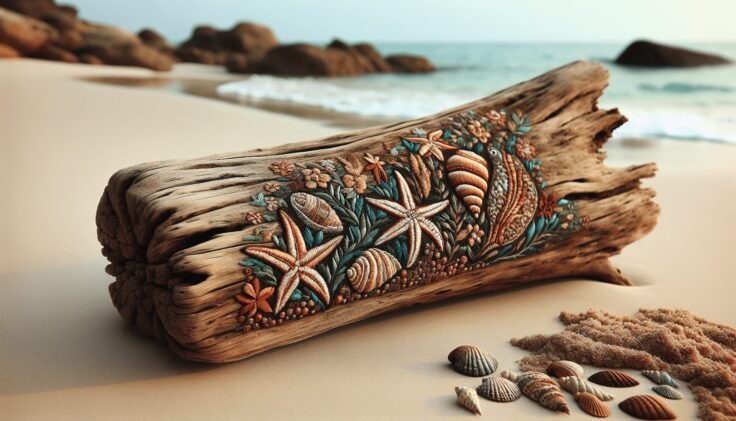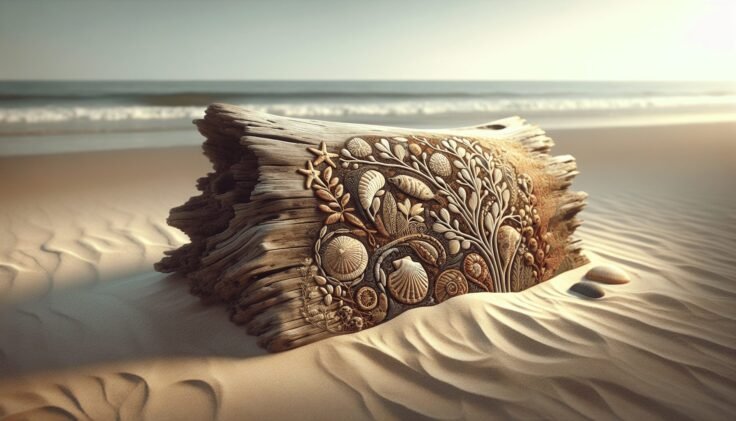Have you ever come across pieces of driftwood on a walk along the beach and wondered how you could transform those seemingly insignificant finds into something beautiful and unique? If so, you might be thrilled to discover the enchanting world of driftwood embroidery. This creative art form combines the natural beauty of driftwood with the intricate craft of embroidery, leading to unique pieces that tell a story all their own.

What is Driftwood Embroidery?
Driftwood embroidery is an innovative art form where the raw and rustic charm of driftwood serves as the canvas for embroidery. By stitching various patterns directly onto the wood, you can create stunning pieces of art that beautifully highlight the synergy between natural elements and artistic expression. Driftwood, with its weathered and unique form, provides an exceptional backdrop for embroidery, offering a tactile and visually intriguing base for your creativity.
The Origins of Driftwood Embroidery
The origins of driftwood embroidery are a bit elusive, as it is a relatively new artistic trend gaining popularity among craft enthusiasts and artists. The practice draws inspiration from traditional embroidery techniques, adapting them to suit the unique challenges and opportunities presented by driftwood. The concept thrives on the idea of sustainability and natural beauty, resonating with artists who find inspiration in nature.
Why Choose Driftwood?
Understanding the appeal of driftwood is essential in appreciating why it has become a favored choice for this craft. Driftwood pieces are not just sustainable; they tell stories of their journeys through waters, shaped by tides and time.
Unique Aesthetic Charm
Driftwood offers an organic and rustic charm that is hard to replicate with other materials. Each piece of driftwood is distinctive, characterized by texture, color, and shape. This uniqueness adds to the allure of any artwork you create with it, making your project one-of-a-kind.
Environmental Significance
Choosing driftwood also reflects an environmentally conscious decision. By using these natural materials, you are repurposing what could otherwise be waste, making art that speaks to sustainability and environmental mindfulness.
Tools and Materials for Driftwood Embroidery
Getting started with driftwood embroidery doesn’t require an extensive list of tools or materials, making it accessible to enthusiasts at various levels of expertise.
Basic Tools You Need
- Needles: Opt for sturdy embroidery needles since you’ll be working on a tougher surface than fabric. Thicker needles will pierce the wood without bending easily.
- Embroidery Floss or Yarn: Choose materials based on color preference and thickness. Yarn works well for larger pieces, while embroidery floss is ideal for finer details.
- Drill or Awl: To create holes for stitching, a hand drill or an awl is necessary. Select a drill bit size similar to the thickness of your needle.
Choosing Your Driftwood
Selecting the right piece of driftwood is crucial. Look for pieces that are relatively flat and not too brittle, as these will hold stitches better. Additionally, the size of your project will guide the scale of driftwood you should seek.

Getting Started with Your First Driftwood Embroidery Project
Embarking on your first driftwood embroidery project can be both exciting and slightly daunting. Here’s a step-by-step guide to help you navigate the process with ease.
Preparing Your Driftwood
- Clean the Driftwood: Begin by cleaning the driftwood to remove any debris or salt. You can soak it in fresh water for a few days and then let it dry completely.
- Plan Your Design: Sketch your embroidery design on paper. Consider the natural contours of the driftwood, as these can contribute to the overall aesthetic.
Marking and Drilling
Mark where you want your stitches to go with a pencil. Carefully drill small pilot holes at these points to prevent the wood from splitting and to make stitching easier.
Stitching the Design
With your driftwood prepped, you can start your embroidery. Thread your needle and begin sewing along the pre-drilled holes, following your design sketch. Experiment with different stitches like the backstitch, chain stitch, or French knot to add texture and variety.
Advanced Techniques and Ideas
Once you’ve mastered the basics of driftwood embroidery, there are numerous possibilities to explore in terms of design complexity and technique.
Incorporating Other Elements
To enhance your artwork, consider integrating other natural elements into your embroidery. Sea glass, shells, or feathers can complement the driftwood and add additional dimensions to your art piece.
Experimenting with Color
Don’t shy away from using bold colors in your embroidery floss. The neutral tones of driftwood can beautifully offset vibrant threads, creating a striking contrast that makes your design pop.
Inspiration from Driftwood Artists
For those seeking inspiration, looking at the works of established driftwood artists can ignite creativity and provide new ideas for your projects.
Notable Artists and Their Work
While driftwood embroidery is niche, several artists have carved a name for themselves with their unique interpretations. Although not widely known, the artistic community praises the nuanced style and innovation these artists bring to the craft.
Finding Your Style
As you evolve in your craft, you’ll begin to develop your style. Experimentation is key, so don’t hesitate to try new techniques and ideas until you find what resonates most with you.
Common Challenges in Driftwood Embroidery
Like any art form, driftwood embroidery comes with its challenges, particularly for beginners. Recognizing these early on can make your creative process more enjoyable.
Handling Tough Material
Driftwood can be an unforgiving medium, with some pieces being too hard or brittle. Learning to select and prepare the right kind of driftwood is essential for ease of embroidery.
Balancing Design and Simplicity
While it can be tempting to go overboard with intricate designs, sometimes simplicity is more impactful. Finding this balance is a skill that develops with experience.
Benefits of Embracing Driftwood Embroidery
Exploring driftwood embroidery extends beyond crafting beautiful art. It offers several personal and environmental benefits.
A Calming and Therapeutic Process
Engaging in the methodical process of embroidery has been known to reduce stress and promote mindfulness. Combining this with the tactile experience of working with natural materials can be incredibly calming and rewarding.
Connecting with Nature
Artistic expression through driftwood embroidery can deepen your appreciation and connection to the natural world, teaching you to see beauty in overlooked materials.
Sharing Your Driftwood Embroidery Creations
Once you’ve completed a project, sharing your work can be a fulfilling part of the creative process.
Creating an Online Presence
Social media platforms like Instagram offer great ways to share your creations and connect with fellow enthusiasts. You can find inspiration, receive feedback, and even start a small business selling your art.
Engaging with the Community
Participating in online forums and local workshops can foster community connections. Being part of a creative group expands your horizons and continuously supplies you with new techniques and tips.
Conclusion
Driftwood embroidery provides a unique intersection of nature and artistry, offering endless possibilities for creativity. With an understanding of the materials and techniques, you can transform simple pieces of driftwood into remarkable artworks that reflect both personal expression and the beauty of the natural world. As you continue to explore this craft, remember that the ease and joy come with practice, patience, and a passion for creativity. Embrace the imperfections of your materials, and let each piece tell its own tale through thread and wood.



